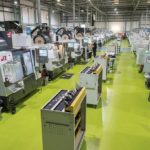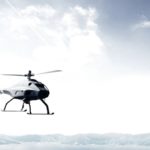Saving lives in space and saving time, weight and money on Earth – 3D printing is now a major element of the aerostructures business, says Alan Peaford.
It wasn’t that long ago that 3D printing was the thing of science fiction writers, but it is now being taken seriously by manufacturers across the industrial sectors.
Aerospace is no different. Additive manufacturing is becoming a speciality at airshows and conferences as the industry gets to grips with the huge potential.
At Farnborough International Air Show in 2018, it was predicted that by 2021, 75% of new commercial and military aircraft will contain 3D-printed parts.
At the moment the parts may be small, like a thrust lever, but they are getting bigger and steadily moving up the value chain.
Drivers for 3D printing
According to a new report from ResearchandMarkets, the global aerospace and defence 3D printing market is currently estimated at $1.56 billion and is expected to grow to $5.9 billion by 2026, at a CAGR of around 15.93%.
The report says that key drivers are reductions in manufacturing time and raw material, translating into direct cost saving and more efficient deployment.
Dr Adriana Marais quantum biologist from the Mars One project told the FINN Sessions conference at Farnborough that 3D printing would be vital to making space exploration viable – and safer.
“3D printing can work in medicine and make bones. We will have Internet on Mars and 3D printing will be essential for engineers to replace or build equipment,” she said.
While that may still be a decade away, on Earth airlines are seeing the potential and are investing in 3D printing capabilities within their own facilities. These in-house centres are expected to produce cabin interior components. Examples of airlines which have invested in an in-house 3D printing facility include Air New Zealand, Etihad and Emirates.
Etihad Airways Engineering agreed a strategic partnership in December to expand industrial 3D printing in Abu Dhabi for cabin interiors.
The partnership was agreed at the Abu Dhabi Grand Prix, where visitors to the race were able to view a full-scale, 3D-printed front wing of a Formula 1 car.
Airline advantages
Neighbouring Emirates has also used the cutting-edge 3D printing technology to manufacture components for its aircraft cabins. Utilising Selective Laser Sintering (SLS), it has produced video monitor shrouds as well as air vent grills.
The Dubai airline says the reduced weight of printed components combined with greater strength is a real advantage, quoting weight savings of up to 13%. This has the potential to lead to significant reductions in fuel emissions and costs when consolidated over the entire fleet of Emirates aircraft.
For the major airlines, this venture into the world of self-made components offers great advantages. With the airlines being able to print parts on demand within a smaller timeframe, they will no longer have to hold a large inventory of spare components or have to go through long wait times for replacements.
This, in turn, puts pressure on the broader component manufacturing industry. The world’s largest aircraft interiors forum, AIX, which place in Hamburg in April, will address the issue.
Tackling counterfeiting
Legacy manufacturers are also facing concerns over counterfeiting – already an issue in aircraft parts. A group of researchers from the NYU Tandon School of Engineering is developing a way to protect part integrity by converting QR codes, bar codes, and other passive tags into 3D features that are hidden inside 3D-printed objects. The codes are embedded in a way that will neither compromise the integrity of the 3D-printed object or be obvious to any counterfeiters attempting to reverse-engineer the part.
The next generation of aircraft will see greater elements of 3D printing. Supersonic is no exception.
Stratasys has signed a technical partnership agreement with Boom Supersonic to brings its FDM 3D printing technology to help Boom fast-track the development of advanced tooling and production-grade aircraft parts.
In a FINN interview, Stratasys’ Jim Orrock said that while 3D printing offers great potential for aerospace, one of the key things slowing adoption has been the process of achieving airworthiness certification from authorities such as the FAA (Federal Aviation Administration) and EASA (European Aviation Safety Agency).
Stratasys claims that its Aircraft Interiors Certification Solution removes major obstacles and makes it much easier to 3D print airworthy parts.
Disruptors show the way
The majors, like Boeing and Airbus, are working hard on keeping up with the disruptors. Airbus reports 25% weight savings in components such as latches for doors on aircraft like the A350.
Airbus’s helicopter division is stepping up to full production this year to manufacture doors for all Airbus aircraft programmes as a supplier. The redesign of the latch shafts and the new production process have resulted in Airbus’s first large-scale production using metallic 3D printing.
More than a third of the components in GE’s advanced turboprop (ATP) engine, rated at 1,300 shaft horsepower, will be built through additive manufacturing methods, including 3D printing, the company said. The engine will power Textron Aviation’s upcoming business aircraft, the Cessna Denali.
Meanwhile, Rolls-Royce Intelligent Engine will help to repair itself according to a FINN interview with Richard Goodhead. The company’s Advance engine technology is embracing 3D printing to achieve weight and environmental improvements.
The technology also helps resolve issues of complexity. According to Tim Hope, Additive Manufacturing Center Manager at GKN Aerospace, 3D printers are cutting lead times for production-line tools and helping to create complex parts which are impossible to make with traditional manufacturing methods.
The future looks bright
An ABI Research survey reveals that 44% of manufacturing companies currently have 3D printers in operation, although most of these deployments are for prototyping purposes only.
ABI says this is set to change over the next 10 years as FAA and EASA approve more 3D-printed parts for use in commercial jet engines, and additive manufacturing (AM) specialists continue to innovate for production-scale implementation in other industries.

